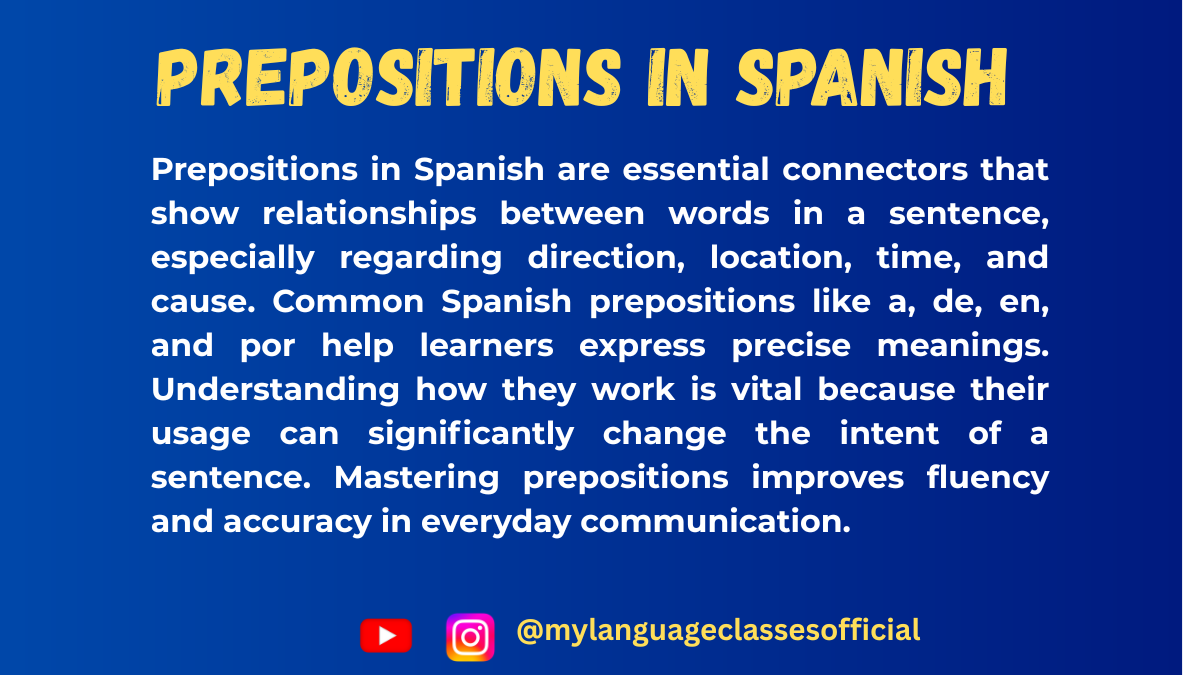Your cart is currently empty!
Tag: my language classes
-
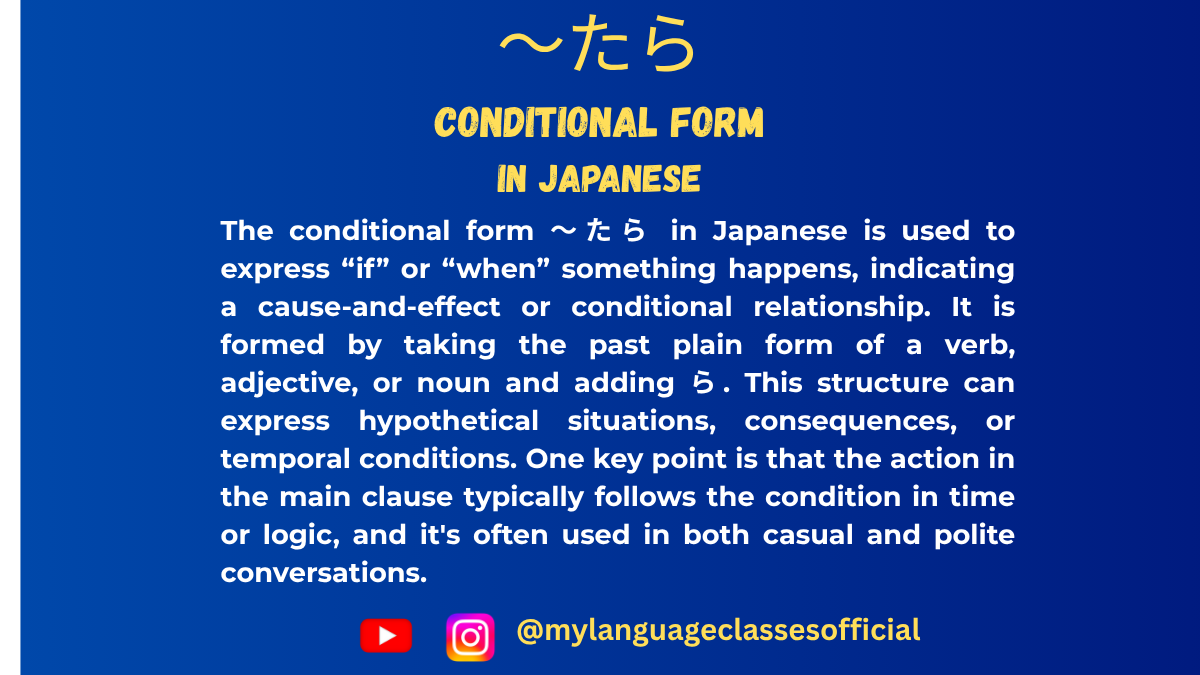
Understanding Conditional form ~たら in Japanese
Understanding ~たら in Japanese
Learning Japanese grammar often feels like solving a puzzle, where each piece contributes to your fluency. One such critical piece is the ~たら structure, a conditional form that translates roughly to “if” or “when” in English. In this blog post, we’ll break down how to use ~たら effectively, covering its structure, usage, and nuances, along with examples to boost your confidence.
What is ~たら?
The ~たら structure comes from the past tense form of a verb, adjective, or noun, combined with ら (ra). It’s used to express conditional situations, which means it helps us talk about “if” or “when” something happens.
Key Functions of ~たら:
- Expressing Conditions: “If X happens, then Y will occur.”
- Temporal Sense: “When X happens, Y will follow.”
This dual meaning is a hallmark of ~たら, and context determines whether it means “if” or “when.”
The Structure of ~たら
Let’s look at how to form ~たら for different word types:
1. Verbs
- Take the plain past tense form (た-form) of the verb + ら.
- Example:
食べる → 食べた → 食べたら (if/when [I] eat)
2. Adjectives
- For い-adjectives, replace the final い with かったら.
- Example: 高い → 高かった → 高かったら (if/when [it’s] expensive)
- For な-adjectives, use the structure: adjective + だったら.
- Example: 静か → 静かだったら (if/when [it’s] quiet)
3. Nouns
- Combine the noun with だったら.
- Example: 休み → 休みだったら (if/when [it’s] a holiday)
Usage Examples
Let’s explore ~たら in action, both as “if” and “when.”
1. Conditional “If”
- 日本に行ったら、寿司を食べたいです。
(Nihon ni ittara, sushi o tabetai desu.)
If I go to Japan, I want to eat sushi. - 時間があったら、映画を見ましょう。
(Jikan ga attara, eiga o mimashou.)
If we have time, let’s watch a movie.
Here, the meaning hinges on a hypothetical condition being met.
2. Temporal “When”
- 家に帰ったら、宿題をします。
(Ie ni kaettara, shukudai o shimasu.)
When I get home, I’ll do my homework. - 雨がやんだら、公園で遊びましょう。
(Ame ga yandara, kouen de asobimashou.)
When the rain stops, let’s play at the park.
In these examples, ~たら conveys a temporal relationship, emphasizing a sequence of events.
Nuances and Tips
- Avoid Overlapping ~たら with ~と or ~ば
While ~と and ~ば also express conditions, ~たら is more versatile because it handles both “if” and “when.” However, ~と is more deterministic (e.g., water boils when heated), and ~ば can feel more formal or speculative. - Expressing Surprise or Discovery
~たら is also used to convey unexpected results:- ドアを開けたら、猫がいました。
(Doa o aketara, neko ga imashita.)
When I opened the door, there was a cat.
Here, the speaker did not anticipate finding a cat.
- ドアを開けたら、猫がいました。
- Avoid Using ~たら for Certainties
If an event is guaranteed to occur (e.g., the sun rising), use a temporal marker like ~時 instead of ~たら.
Practice Time!
Try making your own sentences using ~たら. Here are some prompts to get you started:
- What would you do if you won the lottery?
宝くじに当たったら、______。 - What will you do when the weekend comes?
週末になったら、______。
Share your answers in the comments or with your language partner. Practice makes perfect!
Final Thoughts
The ~たら structure is a cornerstone of Japanese conditional grammar. By mastering it, you’ll unlock the ability to express complex ideas about possibilities and sequences. Remember to pay attention to context to distinguish between “if” and “when,” and don’t hesitate to experiment with it in your conversations.
Ready to elevate your Japanese skills? Try using ~たら today!
If you enjoyed this lesson, be sure to check out more posts like this on my blog at My Language Classes. Don’t forget to subscribe my YouTube channel and follow me on Instagram for the latest language learning tips and lessons. Leave a comment below to share your thoughts, or ask any questions you have about nouns.
Happy learning! 😊
📚 Continue Learning Japanese
-
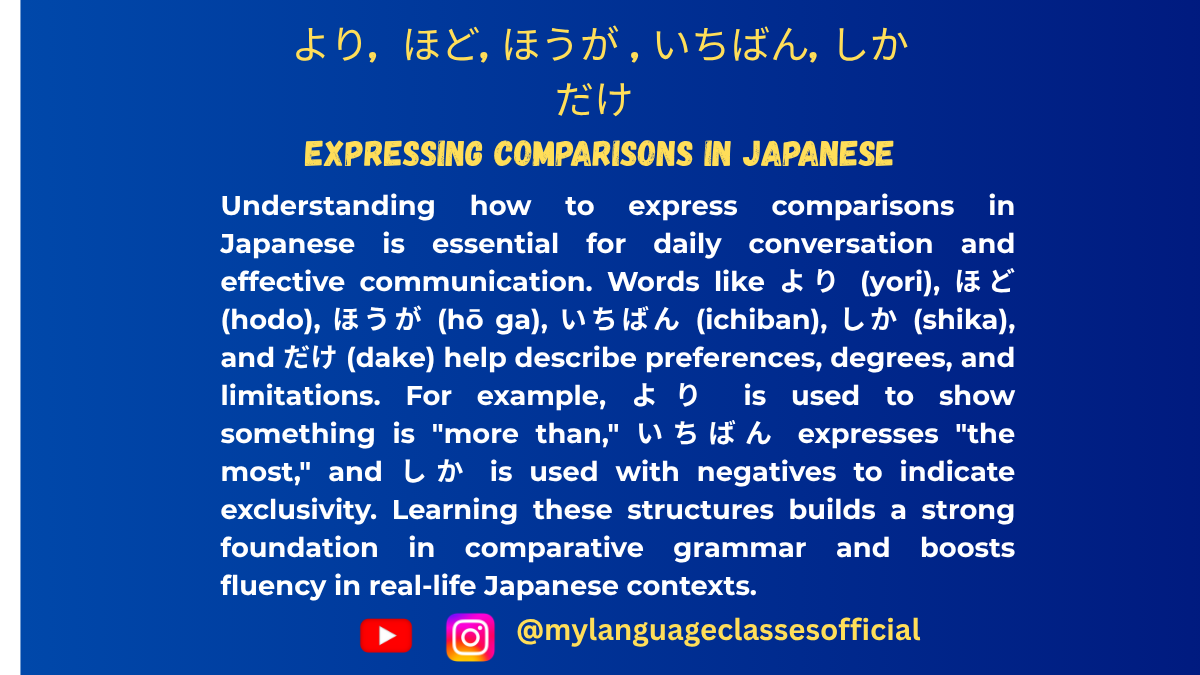
Mastering Comparisons in Japanese より, ほど, ほうが, いちばん, しか, and だけ
Expressing Comparisons in Japanese より, ほど, ほうが, いちばん, しか, and だけ
When learning Japanese, one of the most important concepts is mastering the art of comparisons. Whether you’re talking about how something is “better” or “more” than something else, or simply stating your preference, knowing how to compare effectively helps you express yourself clearly and confidently. In this post, we’ll cover some of the most essential comparison structures in Japanese: より (more than), ほど (more than / to the extent of), ほうが (preference), いちばん (the most), and dive into important distinctions such as より vs ほど and だけ vs しか.
1. より (More Than)
The particle より is used when comparing two items, indicating that one is more than the other. It’s the most straightforward way to show superiority or difference between two things.
Example:
- この映画はあの映画より面白いです。
Kono eiga wa ano eiga yori omoshiroi desu.
This movie is more interesting than that movie.
Here, より is used to compare the two movies, with the first one being more interesting than the second.
2. ほど (More Than / To the Extent of)
ほど is used to express a comparison where something is “more than” another thing, but with a focus on degree or extent. It’s often used when talking about how much more of something there is, especially in terms of actions or abilities.
Example:
- 彼は私ほど速く走れません。
Kare wa watashi hodo hayaku hashiremasen.
He can’t run as fast as I can.
Here, ほど is used to emphasize the difference in the degree of speed. It’s not just “more than” in quantity, but more in terms of ability or extent.
3. より vs ほど (Key Difference)
While both より and ほど can be translated as “more than,” the distinction lies in their nuance:
- より is used for simple comparisons, where one thing is greater or superior than another in a more straightforward sense.
- ほど is used when discussing the degree or extent of a comparison, often involving abilities, qualities, or actions. It can also suggest “to the extent that” or “as much as.”
Example:
- 彼は私より背が高いです。
Kare wa watashi yori se ga takai desu.
He is taller than I am.
(Simple comparison) - 彼は私ほど速く走れません。
Kare wa watashi hodo hayaku hashiremasen.
He can’t run as fast as I can.
(Degree of ability comparison)
4. ほうが (Preference)
The structure ほうが is used to express preference between two things, indicating that one thing is favored over the other.
Example:
- 日本の映画はアメリカの映画より面白いほうが好きです。
Nihon no eiga wa Amerika no eiga yori omoshiroi hō ga suki desu.
I prefer Japanese movies over American movies because they are more interesting.
In this sentence, ほうが emphasizes the preference for Japanese movies compared to American movies.
5. いちばん (The Most)
いちばん is used to indicate the highest degree of something, meaning “the most” or “the best.” It’s used when something stands out as the most in a particular category.
Example:
- 彼女はクラスでいちばんかわいいです。
Kanojo wa kurasu de ichiban kawaii desu.
She is the most beautiful in the class.
Here, いちばん is used to express that she is the top or number one in terms of beauty.
6. だけ (Only) vs しか (Only, but Negative)
Another pair worth noting in comparisons is だけ and しか. Both can be translated as “only,” but the way they are used is quite different.
- だけ is used to indicate a positive statement or simple limitation.Example:
- このレストランには寿司だけがあります。
Kono resutoran ni wa sushi dake ga arimasu.
This restaurant only has sushi.
- このレストランには寿司だけがあります。
- しか is used with a negative verb, indicating “only” but with the sense that there is nothing more than that (often implying something less than expected).Example:
- このレストランには寿司しかありません。
Kono resutoran ni wa sushi shika arimasen.
This restaurant only has sushi (and nothing else).
- このレストランには寿司しかありません。
Notice that with しか, a negative verb is required, while with だけ, the statement can be positive.
Tips for Mastering Comparisons
- Understand the Context: Pay attention to whether you’re making a straightforward comparison or discussing degrees of difference. This will help you choose between より and ほど.
- Practice with Real-Life Examples: Try comparing things you see around you. For example, compare two foods, two movies, or two places. This helps you internalize comparison structures.
- Use ほうが for Preferences: If you’re ever unsure about how to express a preference, use ほうが. It’s a simple way to show that you favor one thing over another.
- Avoid Overcomplicating Things: Don’t worry about using every comparison structure at once. Focus on mastering one at a time—start with より and いちばん, then gradually incorporate ほど and ほうが into your conversations.
- Listen to Native Speakers: Pay attention to how native speakers make comparisons. Listening to their natural flow will help you understand which structure to use in various situations.
Final Thoughts: Mastering Comparisons for Fluent Communication
Mastering comparisons in Japanese is a crucial step toward fluency. By understanding how to use より (more than), ほど (more than / to the extent of), ほうが (preference), and いちばん (the most), you’ll be able to express differences, preferences, and extremes with precision and confidence.
Remember that the key to becoming proficient in any aspect of a language is practice. The more you engage with these comparison structures in your speaking and writing, the more natural they will feel.
So, keep practicing, stay curious, and challenge yourself to use comparisons in your everyday conversations. With continued effort and attention to detail, you’ll be able to navigate the nuances of Japanese comparisons and speak like a native speaker in no time. Happy learning!
If you enjoyed this lesson, be sure to check out more posts like this on my blog at My Language Classes. Don’t forget to subscribe my YouTube channel and follow me on Instagram for the latest language learning tips and lessons. Leave a comment below to share your thoughts, or ask any questions you have about nouns.
Happy learning! 😊
📚 Continue Learning Japanese
- この映画はあの映画より面白いです。
-
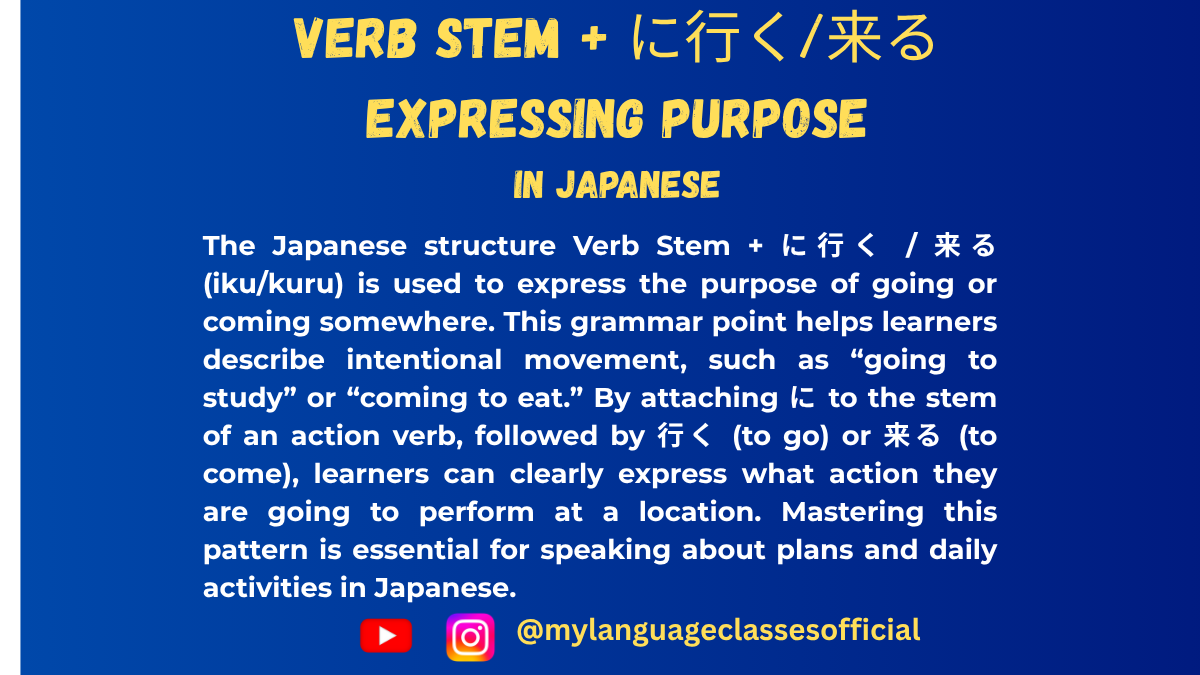
How to Express Purpose in Japanese Verb Stem + に行く / 来る (iku/kuru)
How to Express Purpose in Japanese: The Structure “Verb Stem + に行く/来る
When learning Japanese, one of the key steps toward fluency is understanding how to express purpose. Today, we’ll focus on a practical and widely used grammatical structure: Verb Stem + に行く/来る. This structure is an essential tool for expressing why someone is going somewhere or has come to a specific place.
The Basics: What Does It Mean?
In English, we often say things like, “I go to the park to exercise” or “She comes to the café to study.” In Japanese, you can convey this idea using the Verb Stem + に行く/来る pattern. Here’s how it breaks down:
- Verb Stem: The base form of the verb without its conjugative endings (e.g., ます or る).
- に: A particle indicating the purpose.
- 行く (いく): “To go.”
- 来る (くる): “To come.”
Building the Structure
To form sentences using this structure, follow these steps:
- Start with the stem of the verb that represents the action or purpose.
- Add the particle に.
- End with 行く (if the subject is going to a place) or 来る (if the subject is coming to a place).
Examples:
- To go to eat sushi
→ 寿司を食べに行く
(すしをたべにいく) - To come to study
→ 勉強しに来る
(べんきょうしにくる) - To go to shop
→ 買い物しに行く
(かいものしにいく)
Key Points to Remember
- Focus on the Verb Stem
The “stem” is the form you get when you remove ます from a polite verb or drop the ending る from plain る-verbs.- Example:
食べます → 食べ (stem)
飲む → 飲み (stem)
- Example:
- Particle に
The に particle acts as a marker that connects the purpose to the destination. - Directional Verbs
- 行く implies movement toward a place.
- 来る implies movement toward the speaker’s current location.
- Negative and Past Forms
Like most verbs in Japanese, 行く and 来る can be conjugated.- Negative:
寿司を食べに行かない (I won’t go to eat sushi.) - Past:
勉強しに来た (I came to study.)
- Negative:
Polite and Casual Speech
When speaking with friends, you might use the plain forms 行く and 来る. However, in formal or polite contexts, switch to 行きます and 来ます.
- Polite:
図書館に勉強しに行きます。
(としょかんにべんきょうしにいきます)
“I will go to the library to study.” - Casual:
図書館に勉強しに行く。
(としょかんにべんきょうしにいく)
“I’m going to the library to study.”
Common Mistakes
- Forgetting the Verb Stem
A common error is using the dictionary form instead of the stem. For example:
❌ 食べるに行く
✅ 食べに行く - Mixing Directional Verbs
Be careful to choose 行く or 来る based on the context of movement relative to the speaker.
Practice Makes Perfect
To master this structure, try creating sentences based on your daily activities. For example:
- I will go to the market to buy vegetables.
→ 市場に野菜を買いに行きます。
(いちばにやさいをかいにいきます) - They came to the park to jog.
→ 彼らは公園にジョギングしに来ました。
(かれらはこうえんにジョギングしにきました)
Final Thoughts
The Verb Stem + に行く/来る structure is a powerful and flexible tool for expressing purpose in Japanese. Whether you’re a beginner or advancing in your studies, mastering this form will add clarity and fluency to your communication.
What activity will you use this structure to describe today? Share your example in the comments, and let’s learn together!
If you enjoyed this lesson, be sure to check out more posts like this on my blog at My Language Classes. Don’t forget to subscribe my YouTube channel and follow me on Instagram for the latest language learning tips and lessons. Leave a comment below to share your thoughts, or ask any questions you have about nouns.
Happy learning! 😊
📚 Continue Learning Japanese
-
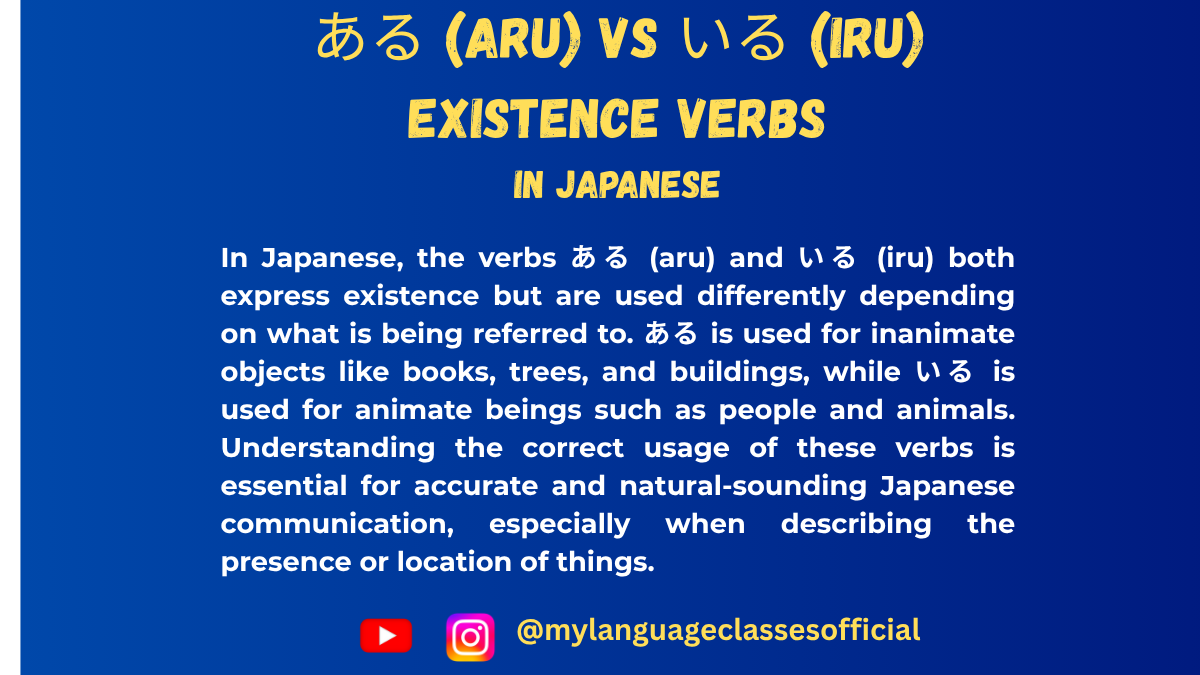
Understanding ある vs いる Japanese Existence Verbs
Japanese Existence Verbs: ある (Aru) vs いる (Iru)
In Japanese, one of the fundamental concepts is the idea of existence, or being. Just like in any language, expressing whether something exists or is present is crucial to communication. In Japanese, this is expressed using two key verbs: ある (aru) and いる (iru).
Though both words translate as “to be” or “to exist,” their usage depends on the type of subject you’re referring to. This difference can be tricky for learners, but once you grasp it, you’ll find yourself speaking more naturally in Japanese.
1. ある (Aru) — Used for Inanimate Objects or Abstract Concepts
The verb ある (aru) is used to express the existence of inanimate objects, things, places, or abstract concepts. If the subject is something that doesn’t have life (like a chair, book, or idea), ある is the correct verb to use.
Examples:
- 本がある。
(Hon ga aru)
“There is a book.” - 学校がある。
(Gakkou ga aru)
“There is a school.”
(Literally, “A school exists.”) - 問題がある。
(Mondai ga aru)
“There is a problem.”
(Literally, “A problem exists.”)
As you can see, ある applies to non-living things—whether they are physical objects, places, or even abstract ideas like problems or opportunities.
2. いる (Iru) — Used for Living Things
On the other hand, いる (iru) is used to indicate the existence of living things, such as people, animals, or any other beings that can move or have consciousness. This includes everything from pets to people to animals.
Examples:
- 犬がいる。
(Inu ga iru)
“There is a dog.”
(Literally, “A dog exists.”) - 先生がいる。
(Sensei ga iru)
“There is a teacher.”
(Literally, “A teacher exists.”) - 友達がいる。
(Tomodachi ga iru)
“I have friends.”
(Literally, “Friends exist.”)
The verb いる is also commonly used to refer to living things when you’re describing their existence in a particular place or context. It’s important to note that いる is for beings that can move, think, or live.
The Difference Between ある and いる
To put it simply:
- Use ある when talking about inanimate objects, things, or places.
- Use いる when talking about living things—people, animals, etc.
How to Make Sentences Negative: ない (Nai)
Just like with other verbs in Japanese, you can make sentences negative by adding ない (nai), which is the negative form of both ある and いる.
- ある becomes ない:
本がない。 (Hon ga nai) — “There is no book.” - いる becomes いない:
犬がいない。 (Inu ga inai) — “There is no dog.”
These negative forms are essential for talking about the absence of something or someone.
Other Uses of ある and いる
- Existence in the Past (だった / いた) Just like in English, we can also talk about past existence in Japanese. あった (atta) and いた (ita) are the past tense forms of ある and いる, respectively.
- 本があった。
(Hon ga atta)
“There was a book.” - 犬がいた。
(Inu ga ita)
“There was a dog.”
- 本があった。
- Describing Location Both ある and いる are also used when talking about the location of things or people. The particles に (ni) or で (de) are typically used to indicate where the subject exists.
- 机の上に本がある。
(Tsukue no ue ni hon ga aru)
“There is a book on the desk.” - 公園に犬がいる。
(Kouen ni inu ga iru)
“There is a dog in the park.”
- 机の上に本がある。
A Helpful Trick to Remember
A simple trick to remember the difference between ある and いる is to think of the phrase “Life is moving.”
- いる for living things = I for I (living being, me, you, animals).
- ある for inanimate things = A for A object.
This small mnemonic can help keep the two verbs straight as you practice!
Conclusion
Understanding ある (aru) and いる (iru) is an essential part of learning Japanese, as it helps you express existence in various contexts. Whether you’re talking about inanimate objects, people, animals, or abstract concepts, knowing when to use each verb will make your Japanese sound more fluent and natural.
If you’re new to learning Japanese, start practicing these verbs with simple sentences and gradually increase complexity. With a little practice, expressing existence will become second nature to you!
If you enjoyed this lesson, be sure to check out more posts like this on my blog at My Language Classes. Don’t forget to subscribe my YouTube channel and follow me on Instagram for the latest language learning tips and lessons. Leave a comment below to share your thoughts, or ask any questions you have about nouns.
Happy learning! 😊
Learn when to use ある (aru) and いる (iru) in Japanese to express existence of things and people with clear rules, tips, and examples.
- 本がある。
-
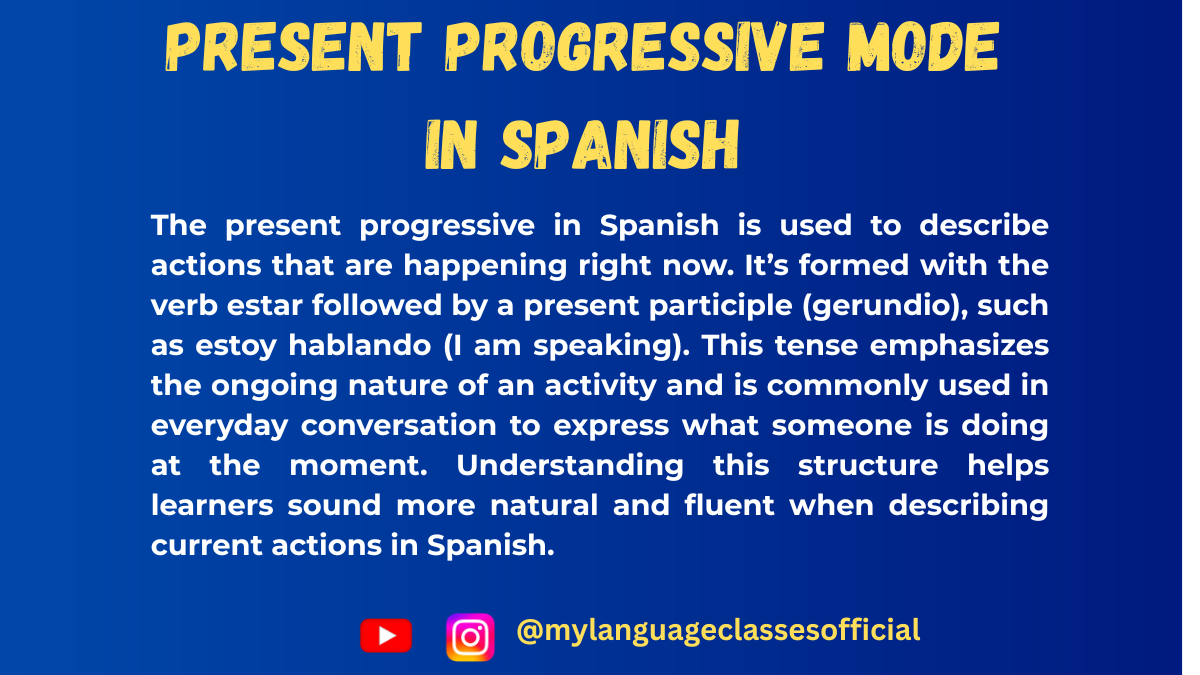
Present Progressive in Spanish
Mastering Present Progressive in Spanish
The present progressive tense (or continuous tense) is one of the most practical and dynamic structures in Spanish. It’s the equivalent of the English “present continuous” tense and is used to describe actions happening right now. If you’ve ever said something like “I am studying” in English, you’ve used a structure similar to Spanish: “Estoy estudiando.”
In this guide, you’ll learn what the present progressive is, how to form it correctly, when to use it, common irregularities, and common mistakes to avoid. Let’s dive in!
What is the Present Progressive?
The present progressive is used to describe actions that are happening right now. It combines the verb estar (to be) as an auxiliary with another verb in its gerund form.
For example:
- Estoy escribiendo (I am writing).
- Estamos aprendiendo español (We are learning Spanish).
How to Form the Present Progressive
1. Conjugate the Verb “Estar”
First, conjugate estar in the present tense according to the subject. Here’s a quick review:
Subject Conjugation of “Estar” Yo estoy Tú estás Él/Ella/Usted está Nosotros/as estamos Vosotros/as estáis Ellos/Ellas/Ustedes están 2. Add the Gerund Form of the Main Verb
The gerund (or present participle) is formed by adding -ando to the stem of -ar verbs and -iendo to the stem of -er and -ir verbs.
Verb Type Example Verb Gerund Form Example -AR Hablar Hablando Estoy hablando (I am speaking). -ER Comer Comiendo Estás comiendo (You are eating). -IR Vivir Viviendo Ellos están viviendo (They are living).
Irregularities in Present Progressive Formation
While most verbs follow the standard -ando/-iendo pattern, some verbs have irregular gerund forms. These can be categorized based on their unique characteristics:
1. Verbs with Spelling Changes
Some verbs change spelling in the gerund to maintain proper pronunciation or avoid awkward letter combinations.
Verb Gerund Form Example Leer Leyendo Estoy leyendo (I am reading). Construir Construyendo Están construyendo (They are building). Oír Oyendo Está oyendo (He/She is hearing). Caer Cayendo Estoy cayendo (I am falling).
2. Stem-Changing Verbs in -IR
Stem-changing verbs that end in -ir modify their stem vowel in the gerund form. These changes occur in verbs that have e → i or o → u shifts in the present tense.
Verb Gerund Form Example Dormir Durmiendo Estoy durmiendo (I am sleeping). Morir Muriendo Está muriendo (He/She is dying). Servir Sirviendo Están sirviendo (They are serving). Pedir Pidiendo Estoy pidiendo (I am requesting).
3. Irregular Verbs with Unique Forms
Certain highly irregular verbs have gerunds that do not follow standard rules.
Verb Gerund Form Example Ir Yendo Estoy yendo (I am going). Poder Pudiendo Está pudiendo (He/She is able to). Venir Viniendo Estamos viniendo (We are coming).
When to Use the Present Progressive
Use the present progressive when describing actions that are happening right now or in the immediate present. Examples include:
- ¿Qué estás haciendo? (What are you doing?)
- Estoy estudiando para un examen. (I am studying for a test.)
- Estamos trabajando en un proyecto. (We are working on a project.)
Common Mistakes to Avoid
- Overusing the Present Progressive In Spanish, the simple present tense is often used instead of the present progressive for habitual actions or near-future events. For example:
- English: I am going to the store tomorrow.
- Correct Spanish: Voy a la tienda mañana. (Not Estoy yendo a la tienda mañana.)
- Incorrect Gerund Formation Remember the spelling and stem changes discussed above. For example:
- Incorrect: Están leiendo.
- Correct: Están leyendo.
- Forgetting to Conjugate “Estar” Always ensure that estar matches the subject of the sentence. For example:
- Incorrect: Ellos está comiendo.
- Correct: Ellos están comiendo.
Practice Exercises
Try these sentences and check your understanding:
- I am listening to music. → (Translate to Spanish)
- We are running in the park. → (Translate to Spanish)
- What are you writing? → (Translate to Spanish)
Conclusion
The present progressive is an essential tool for Spanish learners, especially when you want to describe ongoing actions. By mastering estar + gerundio and learning how to handle irregular verbs, you’ll speak Spanish with greater fluency and confidence. Practice regularly, and don’t be afraid to make mistakes—they are part of the learning process!
¿Qué estás esperando? (What are you waiting for?) Start using the present progressive in your Spanish conversations today!
If you found this guide helpful, I’d love to hear from you! Share your thoughts in the comments below or connect with me on social media. For more tips, resources, and inspiration, visit my blog at mylanguageclasses.in. Follow on Instagram and subscribe on YouTube
📚 Continue Learning Spanish
-
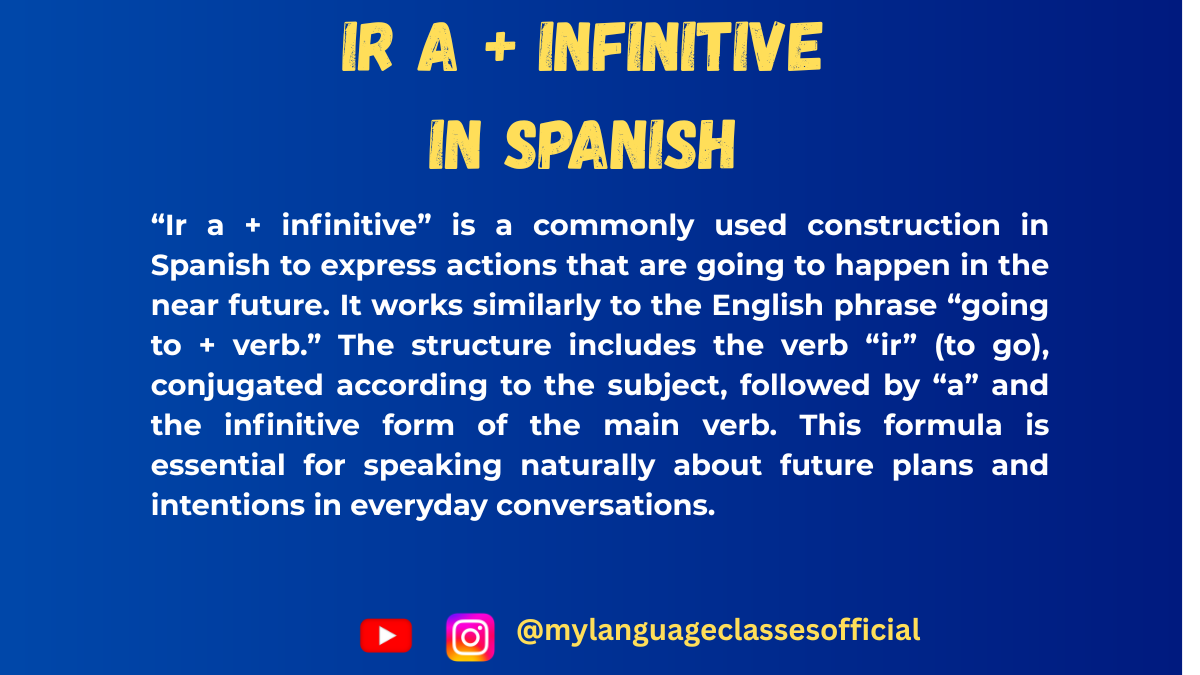
Near Future Tense in Spanish: Mastering Ir a + Infinitive
Near Future Tense in Spanish: Mastering Ir a + Infinitive
If you’re learning Spanish, you’ve likely encountered the phrase voy a estudiar (“I’m going to study”). This construction is an example of the near future tense, a simple and versatile way to talk about events that are going to happen soon. Today, we’ll explore how to use this tense, why it’s so practical, and how it compares to other future forms in Spanish. Let’s dive in!
What is the Near Future Tense?
The near future tense in Spanish uses the verb ir (to go), followed by the preposition a and an infinitive verb. It’s similar to the English construction “to be going to + verb.” For example:
- Voy a bailar. – I’m going to dance.
- Vamos a comer. – We’re going to eat.
- Ellos van a viajar. – They’re going to travel.
This structure is widely used in everyday conversation because it’s straightforward and easy to learn.
How to Form the Near Future Tense
The formula is simple:
[Conjugated form of ir] + a + [infinitive verb]Here’s how you conjugate ir in the present tense:
Subject Pronoun Conjugation of ir Yo voy Tú vas Él/Ella/Usted va Nosotros/as vamos Vosotros/as vais Ellos/Ellas/Ustedes van Once you’ve got ir conjugated, just add a and any infinitive verb:
- Voy a leer. – I’m going to read.
- ¿Vas a escribir? – Are you going to write?
- Ellos van a salir. – They are going to go out.
Why Use the Near Future Tense?
The ir a + infinitive construction is perfect for beginners because it’s less complicated than the simple future tense (hablaré, comerás, vivirán). It’s also highly practical—it allows you to talk about immediate plans or intentions without needing to learn additional verb conjugations.
For example:
- Instead of saying Estudiaré mañana (I will study tomorrow), you can say Voy a estudiar mañana (I’m going to study tomorrow).
- Both are correct, but voy a estudiar feels more conversational and is commonly used in informal settings.
Examples of Near Future in Everyday Situations
- Making Plans
- ¿Qué vas a hacer esta tarde? – What are you going to do this afternoon?
- Voy a ir al cine. – I’m going to go to the movies.
- Expressing Intentions
- Vamos a aprender mucho hoy. – We’re going to learn a lot today.
- Voy a ayudar a mi mamá. – I’m going to help my mom.
- Asking Questions
- ¿Vas a venir a la fiesta? – Are you going to come to the party?
- ¿Van a preparar la cena? – Are they going to prepare dinner?
Tips for Mastering the Near Future Tense
- Practice with Everyday Activities: Make a list of what you’re planning to do tomorrow and describe it using ir a + infinitive. For example, Voy a trabajar. Voy a estudiar. Voy a descansar.
- Combine with Time Expressions: Adding time markers helps specify when the action will happen. For example:
- Voy a salir mañana. – I’m going to go out tomorrow.
- Vamos a viajar en verano. – We’re going to travel in summer.
- Roleplay Common Scenarios: Imagine planning a weekend trip, a day at work, or a family gathering. Use phrases like Voy a comprar comida (I’m going to buy food) or Vamos a visitar a nuestros amigos (We’re going to visit our friends).
Comparison with the Simple Future
While the ir a + infinitive construction is easy and practical, the simple future tense (-é, -ás, -á, -emos, -éis, -án) is also important to learn for more formal or distant future events. For example:
- Voy a estudiar español. – I’m going to study Spanish (soon or in the near future).
- Estudiaré español en la universidad. – I will study Spanish at university (a more formal or distant future).
Conclusion
The ir a + infinitive construction is an essential tool for Spanish learners. It’s simple, flexible, and widely used in real-life conversations. By mastering this tense, you’ll be able to express your plans and intentions with confidence.
So, what are you going to do next? (¿Qué vas a hacer ahora?) Practice using this tense, and you’ll see how quickly it becomes a natural part of your Spanish conversations.
¡Buena suerte! 📝
If you found this guide helpful, I’d love to hear from you! Share your thoughts in the comments below or connect with me on social media. For more tips, resources, and inspiration, visit my blog at mylanguageclasses.in. Follow on Instagram and subscribe on YouTube
📚 Continue Learning Spanish
-
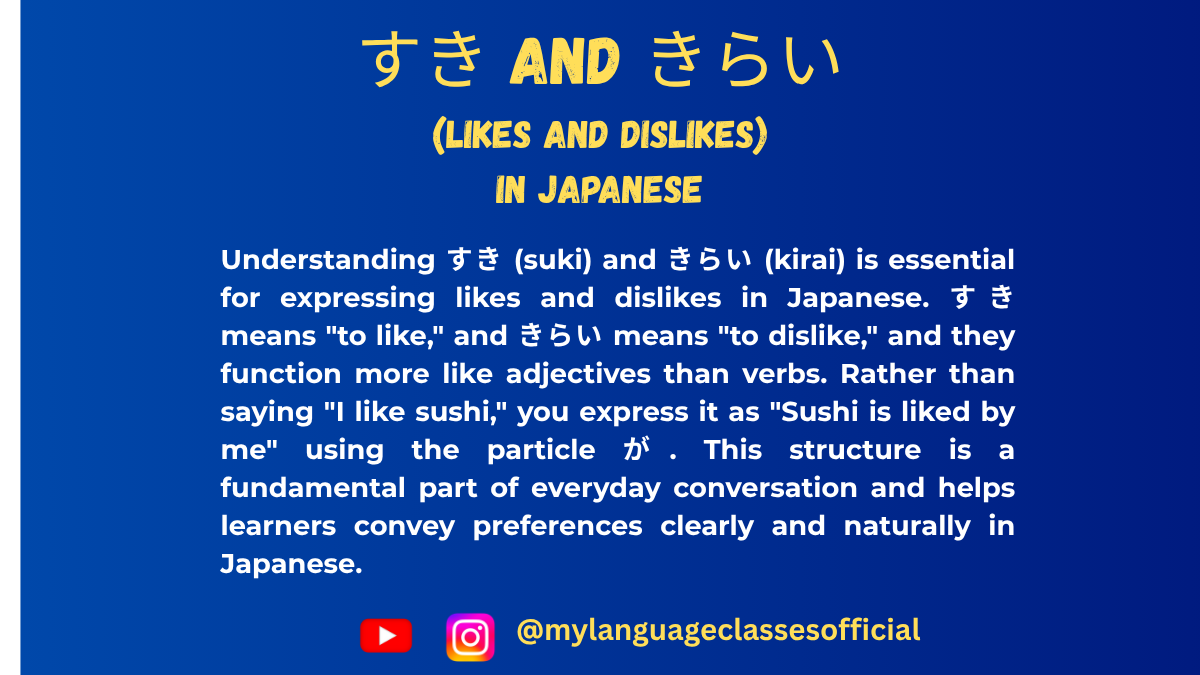
Expressing Likes and Dislikes すき and きらい in Japanese
Likes and Dislikes in Japanese
こんにちは!(Konnichiwa!)
Learning how to express preferences is one of the most useful and fun parts of mastering Japanese. Today, let’s dive into two essential words: 好き (すき) for “like” and 嫌い (きらい) for “dislike.” Not only will we explore their meanings, but also how to use them naturally in sentences.
1. 好き (すき) – To Like
How to Use 好き
The word 好き means “like” or “fond of” and is commonly used to express your preferences. The structure is simple:
Noun + が好き
This translates to “I like [noun].”Examples:
- 日本語が好きです。
Nihongo ga suki desu.
I like Japanese.- Here, 日本語 (Nihongo) means “Japanese,” and が marks it as the topic you like. Adding です makes it polite.
- 犬が好き。
Inu ga suki.
I like dogs.- This informal version is common among friends or in casual settings.
Expressing Love or Passionate Likes
To emphasize your love or deep passion for something, you can use 大好き (だいすき/daisuki):
- チョコレートが大好きです!
Chokorēto ga daisuki desu!
I love chocolate!
2. 嫌い (きらい) – To Dislike
How to Use 嫌い
On the flip side, 嫌い means “dislike” or “hate.” The structure is the same as 好き:
Noun + が嫌い
This means “I dislike [noun].”Examples:
- ピザが嫌いです。
Piza ga kirai desu.
I dislike pizza.- ピザ (Piza) means “pizza.” While it’s a popular dish, some people might find it too greasy!
- 虫が嫌い。
Mushi ga kirai.
I hate insects.- 虫 (Mushi) refers to “insects.” Use this informal structure with friends.
Expressing Strong Dislike
If you strongly dislike something, you can say 大嫌い (だいきらい/daikirai):
- 雨が大嫌いです!
Ame ga daikirai desu!
I hate rain!
3. Cultural Notes
- “Softer Tone for Dislikes”: In Japanese culture, direct expressions of dislike like 嫌い might come off as too strong in some situations. To soften it, you can use phrases like:
- あまり好きじゃない (Amari suki janai) – “I don’t really like [it].”
- ちょっと苦手です (Chotto nigate desu) – “I’m a bit bad with [it].”
- Overuse of 好き: While 好き is positive, saying it too often might sound insincere. Balance your expressions to match the context.
4. Grammar and Nuance Tips
- No Verb Needed:
Both 好き and 嫌い function as な-adjectives, not verbs. This means they don’t need any conjugation or additional verbs to form basic sentences.Example:- Correct: 猫が好きです。 (Neko ga suki desu. – “I like cats.”)
- Incorrect: 猫が好きをです。 (Neko ga suki wo desu. – This is ungrammatical.)
- が (Ga) vs. は (Wa):
Although が is standard for these structures, は can be used for contrast or emphasis:- 犬は好きですが、猫は嫌いです。
Inu wa suki desu ga, neko wa kirai desu.
I like dogs, but I dislike cats.
- 犬は好きですが、猫は嫌いです。
5. Practice Time!
Let’s put what you’ve learned into action. Try completing these sentences:
- 私は ______ が好きです。
(Watashi wa ______ ga suki desu.)- Translate: “I like ______.”
- 友達は ______ が嫌いです。
(Tomodachi wa ______ ga kirai desu.)- Translate: “My friend dislikes ______.”
- ______ は大好きです!
(______ wa daisuki desu!)- Translate: “I love ______!”
6. Wrap-Up
Now you can confidently express what you like and dislike in Japanese! Start practicing by talking about your favorite foods, hobbies, and activities. Try to notice how native speakers use 好き and 嫌い in conversations—it will deepen your understanding.
If you have questions or want to share your sentences, feel free to leave a comment below!
それでは、またね!(Soredewa, matane!)If you enjoyed this lesson, be sure to check out more posts like this on my blog at My Language Classes. Don’t forget to subscribe my YouTube channel and follow me on Instagram for the latest language learning tips and lessons. Leave a comment below to share your thoughts, or ask any questions you have about nouns.
Happy learning! 😊
📚 Continue Learning Japanese
- 日本語が好きです。
-
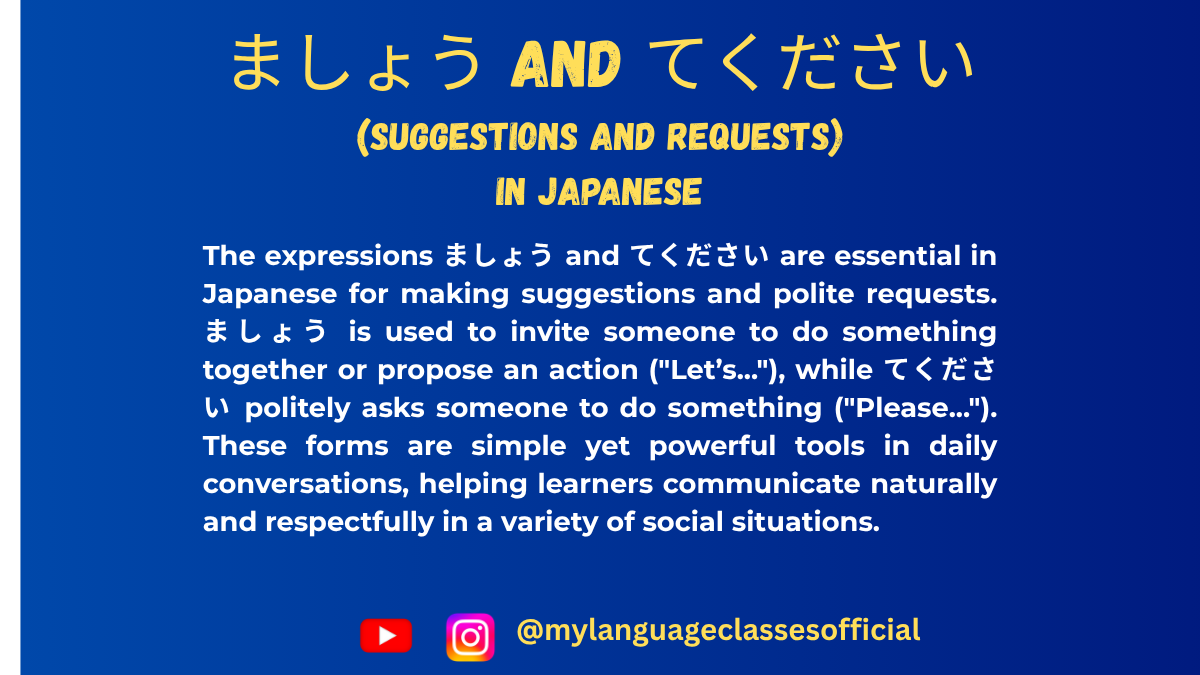
Making Suggestions and Polite Requests ましょう and てください in Japanese
Mastering Polite Suggestions and Requests in Japanese
If you’re learning Japanese, understanding how to make polite suggestions and requests is a key part of effective communication. Whether you’re planning activities with friends or politely asking for help, two common expressions—Verb stem + ましょう and Verb stem + てください—are your go-to tools. Let’s dive into their usage, including how to form them step by step.
1. Making Suggestions with ましょう (mashou): “Let’s [verb]”
The expression ましょう is a polite and versatile way to suggest an activity or propose an idea. It carries a collaborative tone, meaning “Let’s do [verb].”
How to Form the ましょう Form
Japanese verbs are divided into three groups, and the method for creating the ましょう form depends on the group.
Group 1: U-Verbs (Godan Verbs)
- Start with the stem of the verb (remove the u-ending).
- Replace the u sound with the i sound.
- Add ましょう.
Verb Stem Change to i Form Add ましょう Example Translation 行く 行 行き 行きましょう Let’s go. 書く 書 書き 書きましょう Let’s write. 話す 話 話し 話しましょう Let’s talk.
Group 2: Ru-Verbs (Ichidan Verbs)
- Remove the final る.
- Add ましょう.
Verb Stem Add ましょう Example Translation 食べる 食べ 食べましょう Let’s eat. 見る 見 見ましょう Let’s look.
Group 3: Irregular Verbs
There are two irregular verbs, and their ましょう forms are as follows:
Verb Change to Stem Add ましょう Example Translation する し しましょう Let’s do it. 来る (kuru) 来 (ki) 来ましょう Let’s come.
When to Use ましょう
- Planning with others:
Example: 公園へ行きましょう!(Kōen e ikimashou!) = Let’s go to the park! - Encouraging teamwork:
Example: 一緒に勉強しましょう。(Issho ni benkyou shimashou.) = Let’s study together.
The tone is polite, making it suitable for formal and casual settings, as long as it’s a group-oriented activity.
2. Making Requests with てください (tekudasai): “Please [verb]”
Before diving into てください, we need to understand how to form the te-form of verbs. The te-form is one of the most fundamental conjugations in Japanese grammar and is used in various contexts beyond requests, such as making commands, linking actions, and creating the polite request structure てください.
How to Make the Te-Form
Japanese verbs are categorized into three groups, and the rules for forming the te-form differ depending on the group.
Group 1: U-Verbs (Godan Verbs)
For verbs ending in う, つ, る, む, ぶ, ぬ, く, ぐ, す, follow these rules:
- Replace the final u-sound with its corresponding te-form sound:
Ending Te-Form Rule Example う Replace with って 買う (kau) → 買って (katte) = Buy つ Replace with って 立つ (tatsu) → 立って (tatte) = Stand る Replace with って 取る (toru) → 取って (totte) = Take む Replace with んで 読む (yomu) → 読んで (yonde) = Read ぶ Replace with んで 遊ぶ (asobu) → 遊んで (asonde) = Play ぬ Replace with んで 死ぬ (shinu) → 死んで (shinde) = Die く Replace with いて 書く (kaku) → 書いて (kaite) = Write ぐ Replace with いで 泳ぐ (oyogu) → 泳いで (oyoide) = Swim す Replace with して 話す (hanasu) → 話して (hanashite) = Speak
Group 2: Ru-Verbs (Ichidan Verbs)
For verbs ending in る, simply drop る and add て:
- 食べる (taberu) → 食べて (tabete) = Eat.
- 見る (miru) → 見て (mite) = Look.
Group 3: Irregular Verbs
There are only two irregular verbs in Japanese:
- する → して = Do.
Example: 勉強する (benkyou suru) → 勉強して (benkyou shite) = Study. - 来る (kuru) → 来て (kite) = Come.
Forming てください
Once you have the te-form of a verb, simply add ください to make a polite request:
- 見る (miru) → 見て (mite) + ください = 見てください (mite kudasai) = Please look.
- 書く (kaku) → 書いて (kaite) + ください = 書いてください (kaite kudasai) = Please write.
- 手伝う (tetsudau) → 手伝って (tetsudatte) + ください = 手伝ってください (tetsudatte kudasai) = Please help.
When to Use It
- Asking politely:
Example: ちょっと待ってください。(Chotto matte kudasai.) = Please wait a moment. - Giving instructions:
Example: ドアを閉めてください。(Doa o shimete kudasai.) = Please close the door.
This phrase is polite and commonly used in both formal and informal situations.
Key Differences Between ましょう and てください
Expression Purpose Tone Verb stem + ましょう Suggestion: “Let’s do [verb]” Collaborative and inclusive Verb stem + てください Request: “Please do [verb]” Respectful and polite
Quick Practice: Try It Out!
Let’s put these into practice. Can you guess the correct form for each scenario?
- You’re suggesting to a friend: “Let’s watch a movie.”
Hint: The verb is 見る (miru).
Answer: 映画を見ましょう!(Eiga o mimashou!) - You’re asking someone politely: “Please listen to me.”
Hint: The verb is 聞く (kiku).
Answer: 私の話を聞いてください。(Watashi no hanashi o kiite kudasai.)
Conclusion
Mastering ましょう and てください opens up a world of polite and smooth communication in Japanese. By understanding these structures—and learning how to form the te-form and ましょう—you can make suggestions, request actions, and navigate various social situations with confidence. Practice them in your daily conversations, and soon they’ll become second nature!
What are your favorite phrases using ましょう or てください? Share them in the comments below! Or, if you have any questions about Japanese grammar, feel free to ask. Let’s keep learning together—日本語を楽しみましょう!(Nihongo o tanoshimimashou!) 😊
If you enjoyed this lesson, be sure to check out more posts like this on my blog at My Language Classes. Don’t forget to subscribe my YouTube channel and follow me on Instagram for the latest language learning tips and lessons. Leave a comment below to share your thoughts, or ask any questions you have about nouns.
Happy learning! 😊
📚 Continue Learning Japanese

